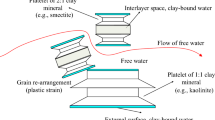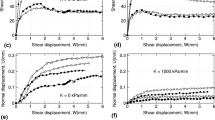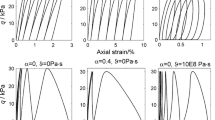Abstract
Clayey soils in the vicinity of energy geostructures may be exposed to long-term periodic thermal cycles. The creep and consolidation behaviors of the clayey soils can be both rate-dependent and temperature-dependent, and the underlying physical mechanisms are merely investigated theoretically. In this study, based on the theory of thermodynamics, a fully coupled thermo-hydro-mechanical (THM) finite element (FE) program for saturated soils is developed for this purpose. The FE formulation accounts for the combined effect of rate and temperature through the novel concept of granular temperature. Simulations of THM coupled validation cases and a series of experimental observations on the soft Bangkok clay are carried out. The obtained numerical results exhibit good agreement with analytical solutions and laboratory measurements. It is found that three fundamental physical mechanisms contribute to the irreversible thermal contraction observed for normally consolidated and lightly overconsolidated clays under drained thermal cycles: (1) the thermal creep excited by mass exchange from adsorbed water to free water; (2) the mechanical creep induced by confining stresses; and (3) the increase in granular packing caused by the thermal expansion of soil particles. The thermal contraction generally stabilizes within a few thermal cycles, as a result of the noticeable reduction in the thermal creep rate. It is further demonstrated that the transient heat transfer and the heating rate can greatly influence the deformation of clays subjected to thermal cycles.











Similar content being viewed by others
Code availability
The code used in this study is available from the corresponding author upon reasonable request.
References
Abuel-Naga HM, Bergado DT, Bouazza A (2007) Thermally induced volume change and excess pore water pressure of soft Bangkok clay. Eng Geol 89:144–154. https://doi.org/10.1016/j.enggeo.2006.10.002
Abuel-Naga HM, Bergado DT, Bouazza A, Ramana GV (2007) Volume change behaviour of saturated clays under drained heating conditions: experimental results and constitutive modeling. Can Geotech J 44:942–956. https://doi.org/10.1139/t07-031
Abuel-Naga HM, Bergado DT, Chaiprakaikeow S (2006) Innovative thermal technique for enhancing the performance of prefabricated vertical drain during the preloading process. Geotext Geomembranes 24:359–370. https://doi.org/10.1016/j.geotexmem.2006.04.003
Abuel-Naga HM, Bergado DT, Ramana GV et al (2006) Experimental evaluation of engineering behavior of soft Bangkok clay under elevated temperature. J Geotech Geoenvironmental Eng 132:902–910. https://doi.org/10.1061/(ASCE)1090-0241(2006)132:7(902)
Bai B, Chang GY, Li T, Sheng YG (2019) A thermodynamic constitutive model with temperature effect based on particle rearrangement for geomaterials. Mech Mater. https://doi.org/10.1016/j.mechmat.2019.103180
Baldi G, Hueckel T, Pellegrini R (1988) Thermal volume changes of the mineral-water system in low-porosity clay soils. Can Geotech J 25:807–825. https://doi.org/10.1139/t88-089
Barla M, Di Donna A, Santi A (2020) Energy and mechanical aspects on the thermal activation of diaphragm walls for heating and cooling. Renew Energy 147:2654–2663. https://doi.org/10.1016/j.renene.2018.10.074
Brandl H (2006) Energy foundations and other thermo-active ground structures. Géotechnique 56:81–122. https://doi.org/10.1680/geot.2006.56.2.81
Brochard L, Honório T, Vandamme M et al (2017) Nanoscale origin of the thermo-mechanical behavior of clays. Acta Geotech 12:1261–1279. https://doi.org/10.1007/s11440-017-0596-3
Burghignoli A, Desideri A, Miliziano S (2000) A laboratory study on the thermomechanical behaviour of clayey soils. Can Geotech J 37:764–780. https://doi.org/10.1139/t00-010
Campanella RG, Mitchell JK (1968) Influence of the temperature variations on soil behaviour. J Soil Mech Found Div ASCE 94:709–734
Cekerevac C, Laloui L (2004) Experimental study of thermal effects on the mechanical behaviour of a clay. J Numer Anal Meth Geomech 28:209–228. https://doi.org/10.1002/nag.332
Chen K, Cole J, Conger C et al (2006) Packing grains by thermal cycling. Nature 442:257–257. https://doi.org/10.1038/442257a
Choo J (2018) Large deformation poromechanics with local mass conservation: an enriched Galerkin finite element framework. Int J Numer Methods Eng 116:66–90. https://doi.org/10.1002/nme.5915
Cui W, Potts DM, Zdravković L et al (2018) An alternative coupled thermo-hydro-mechanical finite element formulation for fully saturated soils. Comput Geotech 94:22–30. https://doi.org/10.1016/j.compgeo.2017.08.011
Cui YJ, Sultan N, Delage P (2000) A thermomechanical model for saturated clays. Can Geotech J 37:607–620. https://doi.org/10.1139/t99-111
Cui W, Tsiampousi A, Potts DM et al (2020) Numerical modeling of time-dependent thermally induced excess pore fluid pressures in a saturated soil. J Geotech Geoenvironmental Eng 146:04020007. https://doi.org/10.1061/(ASCE)GT.1943-5606.0002218
Delage P, Sultan N, Cui YJ (2000) On the thermal behaviour of Boom clay. Can Geotech J 37:343–354. https://doi.org/10.1139/t99-105
Di Donna A, Laloui L (2015) Numerical analysis of the geotechnical behaviour of energy piles. Int J Numer Anal Methods Geomech 39:861–888. https://doi.org/10.1002/nag.2341
Di Donna A, Laloui L (2015) Response of soil subjected to thermal cyclic loading: experimental and constitutive study. Eng Geol 190:65–76. https://doi.org/10.1016/j.enggeo.2015.03.003
Gatmiri B, Delage P (1997) A formulation of fully coupled thermal-hydraulic-mechanical behaviour of saturated porous media—numerical approach. Int J Numer Anal Methods Geomech 21:199–225. https://doi.org/10.1002/(SICI)1096-9853(199703)21:3%3c199::AID-NAG865%3e3.0.CO;2-M
Graham J, Tanaka N, Crilly T, Alfaro M (2001) Modified Cam-Clay modelling of temperature effects in clays. Can Geotech J 38:608–621. https://doi.org/10.1139/t00-125
Guvanasen V, Chan T (2000) A three-dimensional numerical model for thermohydromechanical deformation with hysteresis in a fractured rock mass. Int J Rock Mech Min Sci 37:89–106. https://doi.org/10.1016/S1365-1609(99)00095-7
Haff PK (1983) Grain flow as a fluid-mechanical phenomenon. J Fluid Mech 134:401–430. https://doi.org/10.1017/S0022112083003419
Hiebl M, Maksymiw R (1991) Anomalous temperature dependence of the thermal expansion of proteins. Biopolymers 31:161–167. https://doi.org/10.1002/bip.360310204
Hueckel T, Pellegrini R (1992) Effective stress and water-pressure in saturated clays during heating-cooling cycles. Can Geotech J 29:1095–1102. https://doi.org/10.1139/t92-126
Jenkins JT, Savage SB (1983) A theory for the rapid flow of identical, smooth, nearly elastic, spherical particles. J Fluid Mech 130:187–202
Jiang Y, Liu M (2007) From elasticity to hypoplasticity: Dynamics of granular solids. Phys Rev Lett 99:5–8. https://doi.org/10.1103/PhysRevLett.99.105501
Jiang Y, Liu M (2009) Granular solid hydrodynamics. Granul Matter 11:139–156. https://doi.org/10.1007/s10035-009-0137-3
Johnson KL (1987) Contact mechanics. Cambridge University Press, Cambridge
Kongkitkul W, Kawabe S, Tatsuoka F, Hirakawa D (2011) A simple pneumatic loading system controlling stress and strain rates for one-dimensional compression of clay. Soils Found 51:11–30. https://doi.org/10.3208/sandf.51.11
Laloui L (2001) Thermo-mechanical behaviour of soils. Environ Geomech 5:809–843. https://doi.org/10.1080/12795119.2001.9692328
Laloui L, Cekerevac C (2008) Non-isothermal plasticity model for cyclic behaviour of soils. Int J Numer Anal Methods Geomech 32:189–213. https://doi.org/10.1002/nag
Laloui L, François B (2009) ACMEG-T: Ssoil thermoplasticity model. J Eng Mech 135:932–944. https://doi.org/10.1061/(ASCE)EM.1943-7889.0000011
Li Y, Dijkstra J, Karstunen M (2018) Thermomechanical creep in sensitive clays. J Geotech Geoenvironmental Eng 144:1–11. https://doi.org/10.1061/(ASCE)GT.1943-5606.0001965
Li C, Kong G, Liu H, Abuel-Naga H (2019) Effect of temperature on behaviour of red clay–structure interface. Can Geotech J 56:126–134. https://doi.org/10.1139/cgj-2017-0310
Li C, Laloui L (2016) Coupled multiphase thermo-hydro-mechanical analysis of supercritical CO2 injection: benchmark for the In Salah surface uplift problem. Int J Greenh Gas Control 51:394–408. https://doi.org/10.1016/j.ijggc.2016.05.025
Ma QJ, Ng CWW, Mašín D, Zhou C (2017) An approach for modelling volume change of fine-grained soil subjected to thermal cycles. Can Geotech J 54:896–901. https://doi.org/10.1139/cgj-2016-0459
Ma J, Zhao G, Khalili N (2016) A fully coupled flow deformation model for elasto-plastic damage analysis in saturated fractured porous media. Int J Plast 76:29–50. https://doi.org/10.1016/j.ijplas.2015.07.011
Modaressi H, Laloui L (1997) A thermo-viscoplastic constitutive model for clays. Int J Numer Anal Methods Geomech 21:313–335. https://doi.org/10.1002/(sici)1096-9853(199705)21:5%3c313::aid-nag872%3e3.3.co;2-x
Morinl R, Silva A (1984) The effects of high pressure and high temperature on some physical properties of ocean sediments. J Geophys Res 89:511–526. https://doi.org/10.1029/JB089iB01p00511
Murphy KD, McCartney JS, Henry KS (2015) Evaluation of thermo-mechanical and thermal behavior of full-scale energy foundations. Acta Geotech 10:179–195. https://doi.org/10.1007/s11440-013-0298-4
Ng CWW, Shi C, Gunawan A et al (2014) Centrifuge modelling of installation effects on helical anchor performance in sand. Can Geotech J 13:785–791. https://doi.org/10.1139/cgj-2014-0301
Ochsner K (2008) Carbon dioxide heat pipe in conjunction with a ground source heat pump (GSHP). Appl Therm Eng 28:2077–2082. https://doi.org/10.1016/j.applthermaleng.2008.04.023
Osipov VIV (2012) Nanofilms of adsorbed water in clay: mechanism of formation and properties. Water Resour 39:709–721. https://doi.org/10.1134/S009780781207010X
Plum RL, Esrig MI (1969) Some temperature effects on soil compressibility and pore water pressures. 48th Annu Meet Highw Res Board. Spec Rep 103:231–242
Qiao Y, Ding W (2017) ACMEG-TVP: A thermoviscoplastic constitutive model for geomaterials. Comput Geotech 81:98–111. https://doi.org/10.1016/j.compgeo.2016.08.003
Rui Y, Soga K (2019) Thermo-hydro-mechanical coupling analysis of a thermal pile. Proc Inst Civ Eng - Geotech Eng 172:155–173. https://doi.org/10.1680/jgeen.16.00133
Sloan W (1987) Substepping schemes for the numerical integration of elastoplastic stress–strain relations. Int J Numer Methods Eng 24:893–911. https://doi.org/10.1002/nme.1620240505
Song Z, Hao Y, Liu H (2020) Analytical study of the thermo-osmosis effect in porothermoelastic responses of saturated porous media under axisymmetric thermal loadings. Comput Geotech 123:103576. https://doi.org/10.1016/j.compgeo.2020.103576
Stewart MA, McCartney JS (2014) Centrifuge modeling of soil-structure interaction in energy foundations. J Geotech Geoenvironmental Eng 140:04013044. https://doi.org/10.1061/(ASCE)GT.1943-5606.0001061
Suvorov AP, Selvadurai APS (2009) THM processes in a fluid-saturated poroelastic geomaterial: comparison of analytical results and computational estimates. In: Diederichs M, Grasselli G (eds) Proceedings of the 3rd CANUS Rock Mechanics Symposium. p 4120
Tamizdoust MM, Ghasemi-Fare O (2020) A fully coupled thermo-poro-mechanical finite element analysis to predict the thermal pressurization and thermally induced pore fluid flow in soil media. Comput Geotech 117:103250. https://doi.org/10.1016/j.compgeo.2019.103250
Towhata I, Kuntiwattanaku P, Seko I, Ohishi K (1993) Volume change of clays induced by heating as observed in consolidation tests. Soils Found 33:170–183. https://doi.org/10.1248/cpb.37.3229
Tsutsumi A, Tanaka H (2012) Combined effects of strain rate and temperature on consolidation behavior of clayey soils. Soils Found 52:207–215. https://doi.org/10.1016/j.sandf.2012.02.001
Villar MV, Lloret A (2004) Influence of temperature on the hydro-mechanical behaviour of a compacted bentonite. Appl Clay Sci 26:337–350. https://doi.org/10.1016/j.clay.2003.12.026
Wang H (2018) Research on multi-scale and multi-field thermodynamic constitutive model and its finite element implementation for saturated geomaterials. Tsinghua University, Beijing
Wang H, Cheng X (2017) A thermodynamic model for rate-dependent geomaterials. In: Ferrari A, Laloui L (eds) Advances in laboratory testing and modelling of soils and shales (ATMSS). Springer International Publishing, Berlin , pp 471–478
Wang J, He H, Li M et al (2020) A review and evaluation of thermal conductivity models of saturated soils. Arch Agron Soil Sci. https://doi.org/10.1080/03650340.2020.1771315
Wang K, Wang L, Hong Y (2020) Modelling thermo-elastic–viscoplastic behaviour of marine clay. Acta Geotech 15:2415–2431. https://doi.org/10.1007/s11440-020-00917-9
Wu D, Liu H, Kong G, Ng CWW (2020) Interactions of an energy pile with several traditional piles in a row. J Geotech Geoenvironmental Eng 146:1–9. https://doi.org/10.1061/(ASCE)GT.1943-5606.0002224
Xu S, Scherer GW, Mahadevan TS, Garofalini SH (2009) Thermal expansion of confined water. Langmuir 25:5076–5083. https://doi.org/10.1021/la804061p
Yashima A, Leroueil S, Oka F, Guntoro I (1998) Modelling temperature and strain rate dependent behavior of clays: one dimensional consolidation. Soils Found 38:63–73. https://doi.org/10.3208/sandf.38.2_63
You S, Cheng X, Guo H, Yao Z (2014) In-situ experimental study of heat exchange capacity of CFG pile geothermal exchangers. Energy Build 79:23–31. https://doi.org/10.1016/j.enbuild.2014.04.021
Zhang Z, Cheng X (2015) A thermodynamic constitutive model for undrained monotonic and cyclic shear behavior of saturated soils. Acta Geotech 10:781–796. https://doi.org/10.1007/s11440-015-0389-5
Zhang ZC, Cheng XH (2016) A thermo-mechanical coupled constitutive model for clay based on extended granular solid hydrodynamics. Comput Geotech 80:373–382. https://doi.org/10.1016/j.compgeo.2016.05.010
Zhang Z, Cheng X (2017) A fully coupled THM model based on a non-equilibrium thermodynamic approach and its application. Int J Numer Anal Methods Geomech 41:527–554. https://doi.org/10.1002/nag.2569A
Zhu JG, Yin JH, Luk ST (1999) Time-dependent stress-strain behavior of soft Hong Kong marine deposits. Geotech Test J 22:118–126. https://doi.org/10.1520/GTJ11270J
Zymnis DM, Whittle AJ, Cheng X (2015) TTS model for thermo-mechanical behavior of clay. In: Proceedings of the XVI ECSMGE. pp 4109–4114
Zymnis DM, Whittle AJ, Cheng X (2019) Simulation of long-term thermo-mechanical response of clay using an advanced constitutive model. Acta Geotech 14:295–311. https://doi.org/10.1007/s11440-018-0726-6
Zymnis DM, Whittle AJ, Germaine JT (2018) Measurement of temperature-dependent bound water in clays. Geotech Test J 42:232–244. https://doi.org/10.1520/GTJ20170012
Acknowledgements
The authors gratefully acknowledge the financial support from the 7th Framework Program for Research of European Commission (Grant No. 612665) and National Science Foundation of China (NSFC, Grant No. 51778338). The authors are grateful to Professor Andrew Whittle, Massachusetts Institute of Technology, USA, for the useful discussions and suggestions on the research topic.
Author information
Authors and Affiliations
Corresponding author
Ethics declarations
Availability of data and material
The data used to support the findings of this study are available from the corresponding author upon request.
Additional information
Publisher's Note
Springer Nature remains neutral with regard to jurisdictional claims in published maps and institutional affiliations.
Appendices
Appendix 1: Detailed expressions of the matrices for the THM coupled FE formulation
Appendix 2: THM processes in saturated linear elastic geomaterial
The one-dimensional THM processes in this case study was first proposed by Suvorov and Selvadurai [52] for analyzing the quasi-static response of saturated linear elastic geomaterials subjected to heating. The case serves as a valuable validation of numerical solutions because a rigorous analytical solution has been provided [52].
Consider a one-dimensional elastic soil column of 10 m in height, as shown in Fig.
12. At time t = 0, the column is instantaneously heated from 0 to 100 °C without drainage. During the time ,the bottom end is fixed while the top end has no displacement limit. Accordingly, excess pore pressure builds up within the soil column and the top end elevates due to thermal expansion. Once the entire column reaches 100 °C, the pore pressure and the temperature at the top end are immediately reduced to zero and a constant compressive stress of 10 MPa is applied to the top. Temperature, pore pressure and displacement are observed within the next 365 days.
Figure 12 shows the geometry, the FE mesh and the boundary conditions of the problem. Table
2 lists the soil properties used in the analytical solution by Suvorov and Selvadurai [52] and the way to convert the properties into the FE code. The heat convection is not considered in this case. Degradation from the extended GSH model to a linear elastic model can be completed using the following equation, provided that all other hyperelastic and plastic constitutive parameters are set to zero
where E and v are the Young’s modulus and the Poisson’s ratio.
Figure
13 shows the evolution of temperature, pore pressure and displacement with time and depth in 365 days. A perfect match is found between the FE calculation and the analytical solution. Since the heat convection is not considered, the temperature evolution in Fig. 13a is totally controlled by the effective specific heat and the thermal conductivity according to Eq. (17). In Fig. 13b, the initial excess pore pressure of 36.3 MPa is induced by the elevated temperature (which contributes to 26.3 MPa) and the 10 MPa compressive stress. At Day 100, not only the positive pore pressure induced by heating has been dissipated, but a negative pore pressure has been generated. This is because the thermal expansion coefficient of the liquid phase is set to zero while that of the solid phase isn’t. During the cooling stage, the contraction of solid phase adds a tensile force to the liquid phase which results in the negative pore pressure. Figure 13c shows the displacement along the elastic soil column. The initial displacement is caused by the thermal expansion. The final displacement after temperature returns to zero depends on the relationship between the soil stiffness and the compressive stress applied. In general, the simulation proved the accuracy of the FE code in dealing with THM coupled elastic problems.
Rights and permissions
About this article
Cite this article
Wang, H., Cheng, X. & Chu, J. Finite element analyses of rate-dependent thermo-hydro-mechanical behaviors of clayey soils based on thermodynamics. Acta Geotech. 16, 1829–1847 (2021). https://doi.org/10.1007/s11440-020-01125-1
Received:
Accepted:
Published:
Issue Date:
DOI: https://doi.org/10.1007/s11440-020-01125-1






